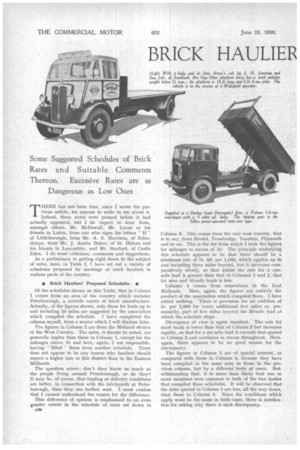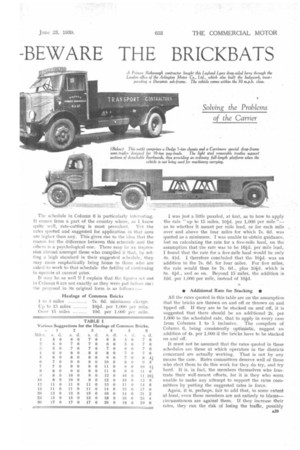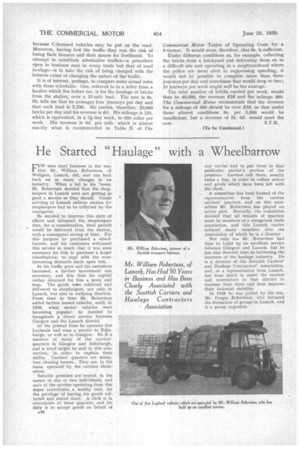BRICK HAULIER -BEWARE THE BRICKBATS
Page 44

Page 45

Page 46

If you've noticed an error in this article please click here to report it so we can fix it.
Some Suggested Schedules of Brick Rates and Suitable Comments Thereon, Excessive Rates are as Dangerous as Low Ones
THERE has not been time, since I wrote the previous article, for anyone to write to me about it. Indeed, these notes were penned before it had actually appeared, but I do expect to hear from, amongst others, Mr. McDowaff, Mr. Lucas or his friends in Luton, from one who signs his letters " H" of Littleborough, from Mr. A. S. Harrison, of Edenthorpe, from Mr. J. Austin Baker, of St. Helens and his friends in Lancashire, and Mr. Starford, of Castle Eden. I do want criticisms, comments and suggestions.
As a preliminary to getting right down to the subject of rates, here, in Table I, I have set out a variety of schedules proposed by meetings of brick hauliers in various parts of the country.
0 Brick Hauliers' Proposed Schedules. • Of the schedules shown on this Table, that in Column 1 comes from an area of the country which includes Peterborough, a notable centre of brick manufacture. Actually, of the figures shown, only those for leads up to and including 10 miles are suggested by the association which compiled the schedule. I have completed the column myself, from a source which I will disclose later.
The figures in Column 2 are from the Midland s6ction of the West Country. The rates, it should be noted, are generally higher than those in Column 1, except for the mileages above 10 and here, again, I am responsible, having " lifted" them from another schedule. There does not appear to be any reason why hauliers should expect a higher rate in this district than in the Eastern Midlands.
The question arises; don't they know as much as the people living around Peterborough, or do they? It may be, of course, that loading or delivery conditions are better, in Connection with the brickyards at Peterborough, than they are farther west. I must confess that I cannot understand the reason for the difference.
This difference of opinion is emphasized to an even greater extent in the schedule of rates set down in A3.4
Column 3. This comes from the real west country, that is to say, from Bristol, Trowbridge, Taunton, Plymouth and so on. This is the list from which I took the figures for mileages in excess of 10. The principle underlying this schedule appears to be that there should be a minimum rate of 7s. Bd. per 1,000, which applies up to and including three miles beyond, but it increases comparatively slowly, so that whilst the rate for a onemile lead is greater than that in Columns 1 and 2, that for nine and 10-mile leads is less,
Column 4 conies from somewhere in the East
Midlands. Here, again, the figures are entirely the product of the association which compiled them. I have added nothing. There is provision for an addition of 2s. per 1,000 for every additional five miles or, presumably, part of five miles beyond the 30-mile lead at which the schedule stops.
Divergence of view is again manifest. The rate for short hauls is lower than that of Column 3 but increases rapidly, so that for a six mile lead it exceeds that quoted in Column 3 and continues in excess throughout. Here, again, there appears to be no good reason for the discrepancy.
The figures in Column 5 are of special interest, as compared with those in Column 4, because they have been compiled in the same area as those in the previous column, but by a different body of users. Notwithstanding that, it is more than likely that one or more members were common to both of the two bodies that compiled these schedules. It will be observed that the rates quoted in Column 5 are less, all the way down, than those in Column 4. Since the conditions which apply must be the same in both cases, there is justification for asking why there is such discrepancy. The schedule in Column 6 is particularly interesting. It comes from a part of the country where, as I know quite well, rate-cutting is most prevalent. Yet the rates quoted and suggested for application in that area are higher than any. This .gives rise to the idea that the reason for the difference between this schedule and the others is a psychological-one. There may be an impression abroad amongst those who compiled it that, by setting a high standard in their suggested schedule, they may more emphatically bring home to those who are asked to work to that schedule the futility of continuing to operate at current sates.
It may be as well f I explain that the figures set out in Column 6 are not exactly as they were put before me: the proposal in its original form is as follows:— Haulage of Common Bricks
to 4 miles 7s. 6d. minimum charge.
Up to 15 miles ..... 100. per 1,000 per mile.
Over 15 miles 10d. per 1,000 per toile.
I was just a little puzzled, at first, as to how to apply the rate "up to 15 miles, 100. per 1,000 per mile' as to whether it meant per mile lead, or for each mile over and above the four miles for which 7s. 6d was quoted as a minimum. I was unable to obtain guidance, but on calculating the rate for a five-mile haul, on the assumption that the rate was to be boo. per -mile lead, I found that the rate for a five-mile haul would be only 4s. zlid. I therefore concluded that the 100. was an addition to the 7s. 6d. for four miles. For five miles, the rate would thus be is. 6d., plus 100, which is 8s. 40., and so on, Beyond 15 miles, the addition is 10d. per 1,000 per mile, instead of 10.0.
• Additional Rate for Stacking •
All the rates quoted in this table are on the assumption that the bricks are thrown on and off or thrown on and tipped off. If they are to be stacked on and off, it is suggested that there should be an additional 2s. per 1,000 to the scheduled rate, that to apply in every case from Columns 1 to 5 inclusive. The compilers of Column 6. being consistently optimistic, suggest an addition of 4s. per 1,000 if the bricks have to be stacked on and off.
It must not be assumed that the rates quoted in these schedules are those at which operators in the districts concerned are actually working. That is not by any means the case. Rates committees deserve well of those who elect them to do this work for they do try, and try hard. It is, in fact, the members themselves who frustrate their well-meant efforts, for it is they who seem unable to make any attempt to support the rates committees by putting the suggested rates in force.
Again, it is, perhaps, fair to add that, to some extent at least, even these members are not entirely to blame— circumstances are against them. If they increase their rates, they run the risk of losing the traffic, possibly because C-licensed vehicles may be put on the road. Moreover, having lost the traffic they run the risk of losing their licences and their means for livelihood. To attempt to substitute alternative traffics—a procedure open to business men in every trade but that of road haulage—is to take the risk of being charged with the heinous crime of changing the nature of the traffic.
It is of interest, perhaps, to compare some actual rates with these schedules. One, referred to in a letter from a. haulier which lies before me, is for the haulage of bricks from the station, over a 15-mile lead. The rate is 8s. He tells me that he averages four journeys per day and that each load is 2,500. He carries, therefore, 10,000 bricks per day and his revenue is £4. His mileage is 120, which is equivalent, in a 5i-day week, to 660 miles per week. His revenue is 8d. per mile, which is almost exactly what is recommended in Table H of The Commercial Motor Tables of Operating Costs for a 5-tonner. It would seem, therefore, that 8s. is sufficient.
Under different conditions as, for example, collecting the bricks from a brickyard and delivering them on to a difficult site and operating in a neighbourhood where the police are more alert in suppressing speeding, it would not be possible to complete more than three journeys per day and sometimes that would drop to two; 16 journeys per week might well be the average.
The total number of bricks carried per week, would thus be 40,000, the revenue £16 and the mileage 480. The Commercial Motor recommends that the revenue for a mileage of 480 should be over £18, so that under these altered conditions 8s. per 1,000 would be insufficient, but a revenue of 9s. 6d. would meet the
case. S.T.R.












































































